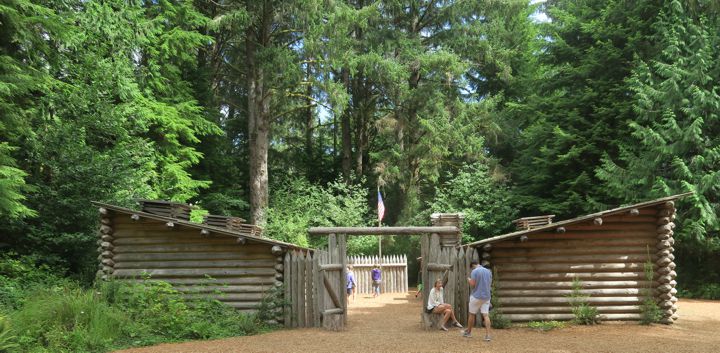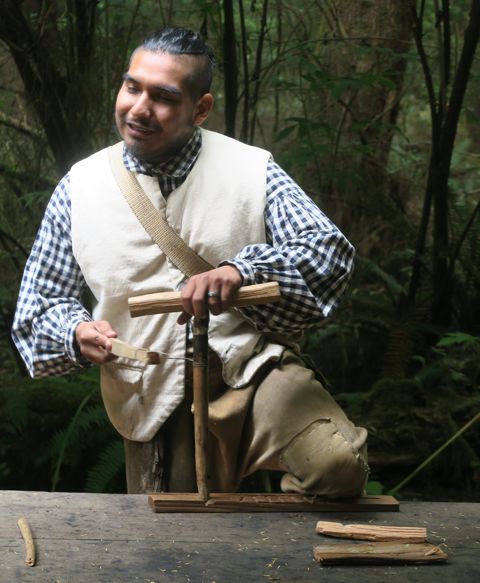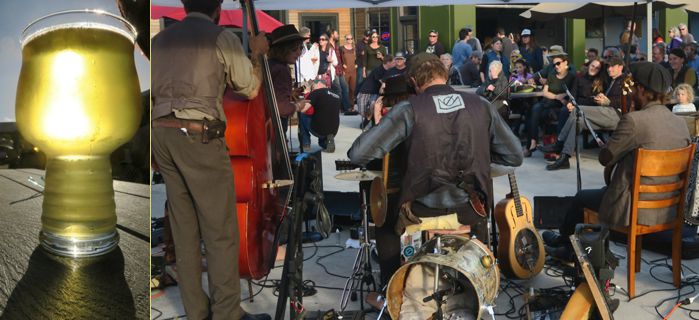| itinerary < Astoria Easy Day 18 August La Push > | Astoria 17 August 2018 |
Another Easy DayAnother one of Rose River Inn's good breakfasts, and some maintenance on this traveling system – the relationship between image sizes and copy wasn't right, and I wanted more freedom from the tyranny of a fixed width browser (the panorama from the Astoria Tower was too pinched!) – before we headed out west to find Lewis and Clark's winter camp at Fort Clatsop National Historic Park |
 |
 |
In the enduring (we hope!) tradition of National Parks, a ranger in "period costume" was busily demonstrating the four methods of fire starting, two 'European' and two indigenous. This one's the bow method. Our instructor asked if any of us had done this, and most of the men – good boy snouts all – raised their hands. "I'm so glad!" he said. "That means I don't have to go through the whole demonstration; it takes a long time." Also in the tradition, an authentic reproduction of the original Fort Clatsop, as best as the historians can determine ...the third, the original and first replica having burned down.
|
 |
We watched a lovely little film told from the perspective of the Clatsop People whose land Lewis and Clark occupied. Clearly, the People, understanding the difficulty the white men faced – they were initially called 'bears' because they were so hairy and dirty, but eventually they were called 'the cloth people' because they didn't wear cedar bark or clothing made from skins: interesting insight into our cultural blindness that we call what people wear 'clothes.' The People were impressed by the presence of the first-nations woman, Sacagawea, and that the military men provided her with her own room and treated her with great respect. The National Park Service has done likewise: out on the path from the Visitors Center to the Fort, there's a lovely brass rendering of Sacagawea and her babe.
I have always been enthralled by the Lewis and Clark story. I'm sure that's one of the reasons I find myself so drawn to Astoria. The little museum here sets the Mission of Discovery in context of the times, and then does all that's possible to establish the unimaginable hardships these men (and one woman) underwent getting here and surviving a winter. |
 |
|
We rode on out to South Jetty. On the way, we watched the trees get shorter and shorter, clear testimony that we were headed out to the edge of the world. At the end of the road, conditions were surprisingly gentle, but it was easy to see how hellish this place would be in a Winter storm. The jetty was constructed clear back at the beginning of the 19th Century in one of "the greatest works attempted by the Corps of Engineers" in an effort to tame the difficult entry to the river; surely there has been some maintenance done despite the difficulty of working here. The original required a railroad to move the enormous rocks used. We walked around the point at Trestle Bay, where the 150-year-old trestle's pilings still march across. |

|
At five o'clock sharp the steam whistle at the Fort George Brewery let loose, and Astoria let down its hair. We had a wait before dinner, so we took in some music and a pint of delicious Reveille Hard Cider while we waited ... ...then a gorgeous seafood Louie III salad at T.Paul's Supper Club:
 |
 |
 |
updated 16 June 2023 Caspar Time site software and photographs by the Caspar Institute except as noted this site generated with 100% recycled electrons! send website feedback to the CI webster © copyright 2002-2024 Caspar Institute |